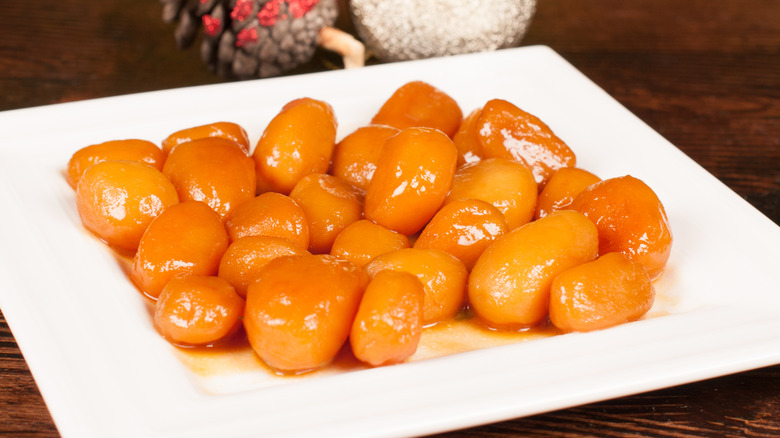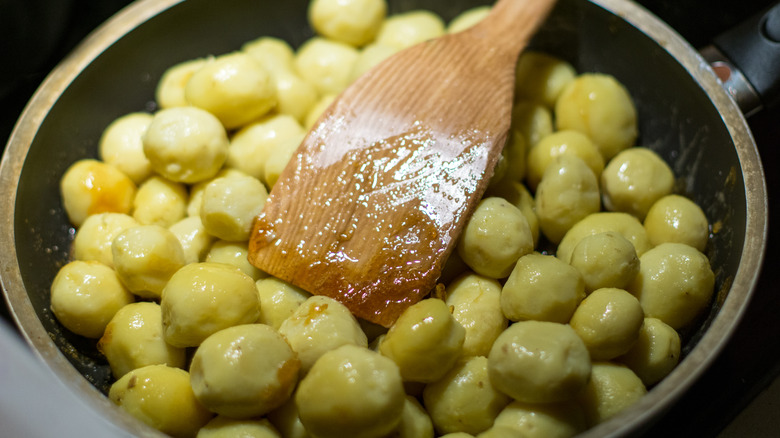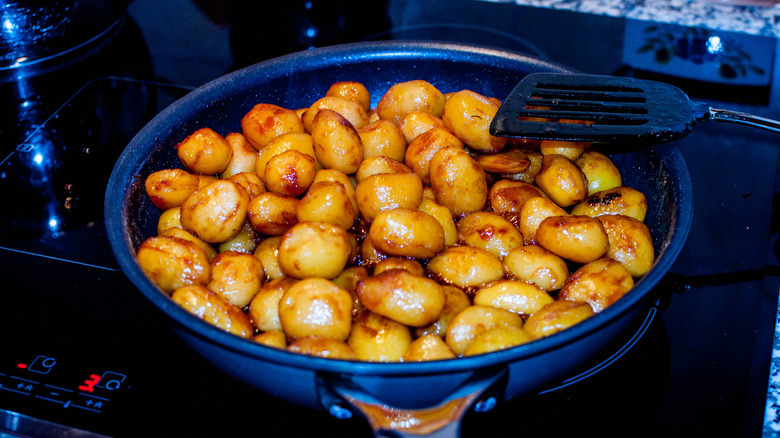Brunede Kartofler, The Caramelized Potatoes From Denmark You Need To Try
Just when you think a plate of cooked potatoes can't get any more delicious, you stumble upon the recipe for the Danish side dish Brunede Kartofler, caramelized potatoes that are often served for holidays and special occasions. Cooked in caramelized sugar, these satisfying morsels will give your favorite sweet potato recipes a serious run for their money.
Whether you scoop up these tasty potatoes alongside juicy tenderloin or pan-roasted pork chops, you will discover that each bite delivers deliciously sweet spuds. The crowd-pleasing dish is usually made with smaller potatoes that have been boiled, peeled, and left to cool before being cooked in a buttery mixture of caramelized sugar. While the recipe sounds simple enough to make, there are certain culinary tips to keep in mind to ensure you produce a dish that a group of hungry Danes would not only approve of, but also ask for second helpings on their plates.
History of sugar-coated potatoes
Brunede Kartofler has been found on dinner tables since the Middle Ages, and the tradition of enjoying this dish during the colder months, particularly around the holiday season, has remained firm. Yet in its original iteration, this dish was made with chestnuts, not potatoes. Since the cost of chestnuts surpassed the price of potatoes, however, many home chefs took it upon themselves to use potatoes in the recipe, thereby forgoing the more expensive ingredient. When paired with meat, the combination of sugary potatoes was equally satisfying, and the chestnuts were hardly missed.
While families with more means snacked on caramel-coated chestnuts along with plates of protein, households with limited resources ladled potatoes onto plates for Christmas celebrations and Morten's aften, the Danish holiday falling on November 11th. Over time, members of all socioeconomic classes discovered how good caramelized potatoes actually are, and regular potatoes became the main component of the sweet side dish served alongside cooked meat.
Perfecting Brunede Kartofler at home
Pick potatoes that are similar in size and can hold their form when cooked in a mixture of butter and sugar. The smaller, firmer potatoes are best for this, and spuds should be completely cooled before you set out to give them the sugary golden treatment of caramelization. If you want to plan ahead, you can leave boiled and peeled potatoes in the fridge overnight, and heat them up the day you intend to serve them as part of your festive roast.
While getting the sugar ready for the potatoes, keep a watch on your pan. If the sugar or caramel burns, your recipe is done for, so you'll want to do what it takes to preserve the integrity of the melted, caramelized sauce. The potatoes will turn light brown, yet you can dictate your preferred level of caramelization on the exterior of your spuds. Some cooks add water to thin out the sugary caramel, and when in a bind, canned and jarred potatoes can be used if the size of the potatoes is small enough. While you can use different sugars for the spuds' coating — Danish chefs use sugar from sugarbeets, but cane sugar and muscovado can also be used — don't skimp on the butter. Reach for the best quality butter you can find and leave the margarine or butter replacement on the shelf for this treat. You won't have leftovers from this recipe.


